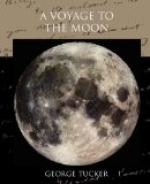Again, Swift’s flying Island of Laputa is a phenomenon so opposed to all scientific probability, and so directly at variance with natural laws, that it loses in interest in a direct ratio with the violence it does to our feelings. Nor is the mode of conveyance imagined by Voltaire less incongruous than that of Swift. When Micromegas, ah inhabitant of Sirius, whose adventures were evidently suggested by those of Gulliver, accompanied by an inhabitant of Saturn, leaves the latter planet, they are, in the first place, made to leap upon the Ring of Saturn, which they find tolerably flat, “comme l’a fort bien devine un illustre habitant de notre petit globe:” thence they go from moon to moon, and a comet passing close to one of these, they throw themselves upon it, with their attendants and instruments. In their course, they fall in with the satellites of Jupiter, and pass on to Jupiter itself, where they remain for a year; but what becomes of the comet in the mean time, we are not informed! Leaving Jupiter, they “coast” along the planet Mars, and finally reach the earth, where they resolve to disembark. Accordingly “ils passerent sur la queue de la comete; et trouvant une aurore boreale toute prete, ils se mirent dedans, et arriverent a terre sur le bord septentrional de la Mer Baltique"![4]
The vehicle, however, has not formed the sole obstacle to those projectors:—the viaticum, especially the food, has been a difficulty not readily got over. Before Bishop Wilkins alludes to his flying chariot, he remarks, that even if men could fly, the swiftest of them would probably be half a year in reaching the end of his journey; and hence a problem would arise, “how it were possible to tarry so long without sleep or diet?” Of the former obstacle, however, he quickly disposes,—“seeing we do not then spend ourselves in any labour, we shall not, it may be, need the refreshment of sleep: but if we do, we cannot desire a softer bed than the air, where we may repose ourselves firmly and safely as in our chambers”! Of the latter he finds




